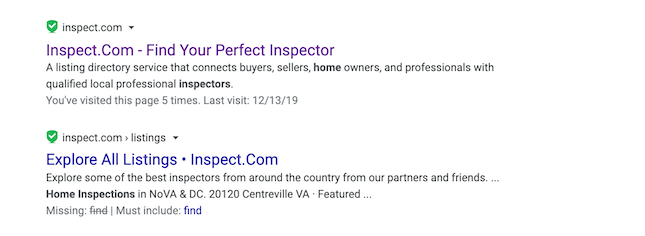
Meta Description: Your Business Billboard
Want to let people know what your web page is about? Create a meta description. A well-designed meta description will display in search results that summarize page content. Done with strategy, a meta description is like an instant mini-ad for your business.
A meta description describes the essence of the page and represents your business brand. In just a few words, your reader can get right to the point. Most importantly, a meta description entices a web searcher to click through and read the page.
What Is a Meta Description?
A meta description is an HTML tag that indicates the description of the web page.
The tag code looks like this (without spaces):
< meta name- ”description” content- ”your powerful mini-ad” >
You place your meta description after “content”-. The tag is placed in the < head > element of the page to describe the page content.
Meta data, like your meta description, is not displayed on the page, but search engines can read the text. It’s like a road sign for the search engine that says, This is what this page is about!
Most website content management systems like WordPress make it easy for you to add the meta description without having to use HTML code. In WordPress.com you add the meta description in Plugins. Plugins like Yoast and INK create a space for you to add a meta description without knowing code. You simply write your meta description as you want it to appear.
Search engines like Google and Bing may use your meta description in search results to describe the page under the page title. In SEO terms, that result is termed a snippet. However, the search engine may choose another part of the page to display in the snippet. Use of your meta description remains at the discretion of the search engine.
Take a look at the search result below:

We don’t know what the meta description for this about page is, but Google selected the first paragraph of the page to show in the snippet. You’ll see the final sentence is cut off because Google allows only a certain amount of characters in the snippet.
Now look at this one:

These two search results display the original meta description text in the snippet. The first example presents the meta description text verbatim. The second example is a hybrid of meta description text and what the search engine pulled from the page.
These three examples illustrate how Google’s search engine picks what displays in the search result snippet, and why meta description is so important to how your page appears in results.
Meta Description Basics
If search engines choose what goes in the snippet, why bother creating a meta description? If you write good content, won’t Google display the right text?
When you create a well-worded meta description, you improve the chances of Google using what you wrote. This is your opportunity to create your mini-ad for the business.
Meta descriptions are limited to approximately 160 characters, including spaces, but you can add power to your meta description by following some simple guidelines. You’ll improve the odds that Google and other search engines will use your text.
You have two goals when creating a meta description: communicating the essence of the web page and using emotionally packed words that entice the reader to click through to read.
Search engines do not use meta descriptions for ranking. But a well-constructed meta description has the power to improve the click through rate (CTR) dramatically when your page is displayed in search. People click through to discover the content on the page. When people go to your page you build brand awareness and increase the potential to convert a sale.
You have two main reasons to use meta descriptions to boost your click through rate:
1. Bold keywords
When words in your meta description match the searcher’s query, those words are displayed in bold. This is a signal that your page content matches the searcher’s question. The main keyword for the page should be in your meta description.
2. Social sharing
When you share a page link of social networks like Facebook or Linkedin, either the meta description or the first paragraph will display as the description. If your meta description is succinct and well worded, it will appear in full as a preview. A first paragraph, however, will be cut off with ellipses (...) and not have the power to get people to read. So if you want people to click through and read from social media, give them a clear reason with a meta description.
Write Your Meta Description
How you phrase your meta description impacts search engine results. In the environment of 155–165 characters, economy of language is essential. To make your meta description connect with the right people, take these steps:
- Research your clients/customers: they're your target audience. Know what steps they take in the buying journey. Know how to funnel actions according to how the page fits into that buying journey. This means targeting your meta description to the stage it sits at in the buying journey.
- Create a tone of voice for your brand. Then keep that tone consistent in your meta descriptions. For example, a game store has a different tone from a hardware store. Match the tone to your customer’s persona. This helps your page description resonate with your target audience.
- Use a keyword that you know your audience searches for when creating a query. Make it appropriate to the page you are describing to help your meta description appear in search.
- Use at least one word that evokes an emotion. Tie that emotion to your target audience's need for your product or service. Reassure, excite, build desire according to your page content.
- Include a short call to action (CTA).
- Test. If your meta description isn’t getting the click through you want, try rewording.
Pro Tip: If your business serves local clients, include your town or area in the meta description.
What Do Meta Descriptions Look Like in Practise?
Let's look at an example.
Here’s a meta description for a page for a construction inspection service targeted toward large scale contractors coming to the end of their projects: Images from punch list projects completed by TMC Services in Denver. See what we found. Save your project and avoid costly mistakes. Schedule your inspection.
This example uses some industry specific terminology, includes an emotive call to action and specifies by area to draw in potential customers.
Be Specific to Your Audience
The idea behind an optimized meta description is to get a searcher to take action, click through, and read the web page. Generic sales speak like “best widget” doesn’t inspire action. Give specifics about the page so the searcher wants to read more.
You want the reader to feel confident that when they click through, they will find the answer to their search. At this point you are not trying to drive them into a sales funnel. Instead, you want to promise you are the person to deliver the answer they want.
Meta descriptions vary by industry. Keep the focus and direction on your target audience. User intent – what they want – is your guideline for forming a meta description that resonates.


